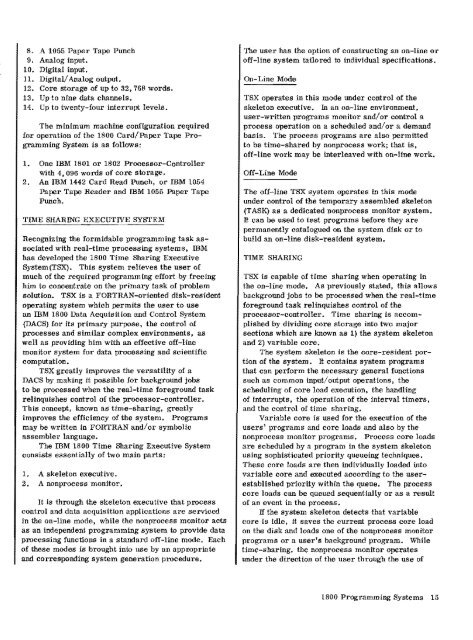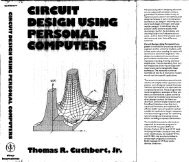Systems Reference Library IBM 1800 System Summary
Systems Reference Library IBM 1800 System Summary
Systems Reference Library IBM 1800 System Summary
Create successful ePaper yourself
Turn your PDF publications into a flip-book with our unique Google optimized e-Paper software.
8. A 1055 Paper Tape Punch<br />
9. Analog Input.<br />
10. Digital Input.<br />
11. Digita!/Analog output.<br />
12. Core storage of up to 32,768 words.<br />
13. Up to nine data channels.<br />
14. Up to twenty-four interrupt levels.<br />
The minimum machine configuration required<br />
for operation of the <strong>1800</strong> Card/Paper Tape Programming<br />
<strong>System</strong> is as follows:<br />
1. One <strong>IBM</strong> 1801 or 1802 Processor-Controller<br />
with 4,096 words of core storage.<br />
2. An <strong>IBM</strong> 1442 Card Read Punch, or <strong>IBM</strong> 1054<br />
Paper Tape Reader and <strong>IBM</strong> 1055 Paper Tape<br />
Punch.<br />
TIME SHARING EXECUTIVE SYSTEM<br />
Recognizing the formidable programming task associated<br />
with real-time processing systems, <strong>IBM</strong><br />
has developed the <strong>1800</strong> Time Sharing Executive<br />
<strong>System</strong>(TSX). This system relieves the user of<br />
much of the required programming effort by freeing<br />
him to concentrate on the primary task of problem<br />
solution. TSX is a FORTRAN-oriented disk-resident<br />
operating system which permits the user to use<br />
an <strong>IBM</strong> <strong>1800</strong> Data Acquisition and Control <strong>System</strong><br />
(DACS) for its primary purpose, the control of<br />
processes and similar complex environments, as<br />
well as providing him with an effective off-line<br />
monitor system for data processing and scientific<br />
computation.<br />
TSX greatly Improves the versatiHty of a<br />
DACS by making it possible for background jobs<br />
to be processed when the real-time foreground task<br />
relinqUishes coutrol of the processor-controller.<br />
This concept, known as time-sharing, greatly<br />
improves the efficiency of the system. Programs<br />
may be written in FORTRAN and/or symbolic<br />
assembler language.<br />
The <strong>IBM</strong> <strong>1800</strong> Time Sharing Executive <strong>System</strong><br />
consists essentially of two main parts:<br />
1. A skeleton executive.<br />
2. A nonprocess monitor.<br />
It is through the skeleton executive that process<br />
control and data acqUisition applications are serviced<br />
in the on-line mode, while the nonprocess monitor acts<br />
as an Independent programming system to provide data<br />
processing functions in a slandard off-line mode. Each<br />
of these modes is brought into use by an appropriate<br />
and corresponding system generation procedure.<br />
The user has the option of constructing an on-line or<br />
off-line system tailored to individual specifications.<br />
On-Line Mode<br />
TSX operates in this mode under control of the<br />
skeleton executive. In an on-line environment,<br />
user-written programs monitor and/or control 11<br />
process operation on a scheduled and/or a demand<br />
basis. The process programs are also permitted<br />
to be time-shared by nonprocess work; that is,<br />
off-line work may be interleaved with on-line work.<br />
Off-Line Mode<br />
The off-line TSX system operates in this mode<br />
under control of the temporary assembled skeleton<br />
(TASK) as a dedicated Donprocess monitor system.<br />
It can be used to test programs before they are<br />
permanently catalogued on tbe system disk or to<br />
build an on-line disk-resident system.<br />
TIME SHARING<br />
TSX is capable of time sharing when operating in<br />
the on-line mode. As previously stated, this allows<br />
background jobs to be processed when the real-time<br />
foreground task relinquishes control of the<br />
processor-controller. Time sharing is accomplished<br />
by dividing core storage into two major<br />
sections which are known as 1) the system skeleton<br />
and 2) variable core.<br />
The system skeleton is the core-resident portion<br />
of the system. It contains system programs<br />
that can perform the necessary general functions<br />
such as common input/output oPElrations, the<br />
scheduling of core load "xecution, the handling<br />
of iuterrupts, the operation of the interval timers,<br />
and the control of time sharing.<br />
Variable core is used for the execution of the<br />
users' programs and core loads and also by the<br />
nonprocess monitor programs. Process core loads<br />
are scheduled by a program in the system skeleton<br />
using sophisticated priority queueing techniques.<br />
These core loads are then individually loaded into<br />
variable core and executed according to the UBerestablished<br />
priority within the queue. The process<br />
core loads can be queued sequentially or as a result<br />
of an event in the process.<br />
If the system skeleton detects that variable<br />
core is idle, it saves the current process core load<br />
on the disk and loads one of the nonprocess monitor<br />
programs or a user's background program. While<br />
time-sharing, the nonprocess monitor operates<br />
under the direction of the user through the use of<br />
<strong>1800</strong> Programming <strong><strong>System</strong>s</strong> 15

















